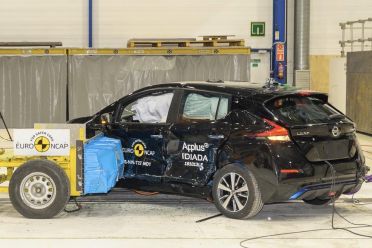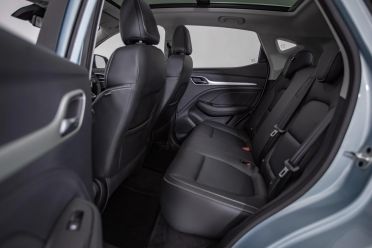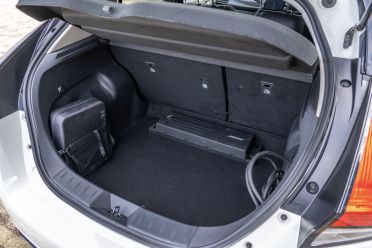It’s no secret the uptake of electric cars in Australia is well behind Europe, China or parts of the USA. For numerous reasons – price, infrastructure, no government subsidies or CO2 caps – our market is not such a happy place for battery-powered fare.
But there are some options out there for prospective early adopters, particularly those who do most of their driving in the city and couldn’t care less about a 500km driving range.
After all, the vast majority of Australians live somewhere like Sydney or Melbourne, not deep in the outback. And for many, an EV could at the very least be a cool second car.
One of the most established and best-known EVs is the Nissan Leaf, which is into its second generation before many rivals have even launched their first.
Alongside Hyundai’s Ioniq, it has owned the entry EV market here for a while, even though sales of both pale in comparison to the Tesla Model 3.
But there’s a new contender on the block, from China. The MG ZS EV is now Australia’s most affordable electric vehicle, and so it makes a perfect competitor to this Japanese (by way of the UK) icon.
Compare the cars
Unpack the key differences in performance, features, and value.

ZS
How much?
The Nissan Leaf wears a list price of $49,990 before on-road costs, equal at the time of writing to $53,190 drive-away. By contrast the MG ZS EV is advertised at $43,990 drive-away.
So there’s a real-world difference of $9200 unless you can twist the arm of your Nissan dealer into a discount.
To give further context, a Hyundai Ioniq Electric can be had for $53,363 drive-away, while a Tesla Model 3 Standard Range Plus is about $72,000 drive-away.
What do you get?
Both get 17-inch alloy wheels, LED daytime running lights, privacy glass, a proximity key fob, and auto-folding mirrors.
Inside each gets heated front seats, climate control, an 8.0-inch touchscreen, satellite-navigation, Apple CarPlay and Android Auto, auto-dimming rear view mirror, and a tyre-pressure monitoring system.
The MG’s sets are trimmed in synthetic leather, while the Nissan’s are a combination of leather and ultra-suede on the bolstering.
The MG gets unique features such as a panoramic (fixed) glass roof, and a powered driver’s seat.
The Nissan counters with unique features such as a temporary spare tyre (a patch kit in the MG), LED headlights (halogen projectors in the MG), an extra speaker (seven versus six), a 360-degree camera view (reversing in the MG), and DAB+ digital radio.
Are they safe?
Both come with dual front, front-side, and curtain airbags.
Each also has safety equipment such as adaptive cruise control, forward collision warning and autonomous emergency braking (AEB), lane-departure warning, blind-spot monitoring, and rear cross-traffic alert. Only the MG’s lane assist steers the wheel actively.
The Leaf has a five-star ANCAP crash test score with a 2018 date stamp, achieving 93 per cent for adult occupant protection, 85 per cent for child occupant protection, 71 per cent for vulnerable road-user protection, and 70 per cent for safety assist.
The petrol-fired MG ZS models have a four-star ANCAP rating, but ANCAP’s sister organisation Euro NCAP (which uses the same procedures) awarded the ZS EV a full five-star rating in 2019, in left-hand drive form.
It scored 90 per cent for adult occupant protection, 85 per cent for child occupant protection, 64 per cent for vulnerable road-user protection, and 70 per cent for safety assist.
What are they like inside?
MG:
The MG offers a more elevated driving position than Nissan, and the driver’s seat electric adjustment offers a wider breadth of positions. The steering wheel is nicely finished and has simple buttons on each spoke, but lacks telescopic/reach adjustment.
There is more in the way of interior storage, including sizeable door bins, a decent centre console, a set of cupholders with a sliding lid, a sunglasses case in the roof, a capacious glovebox, and a small hidden nook below the gear shifter.
The panoramic glass roof is a nice touch, letting in plenty of sunlight, though on a hot Aussie day you’ll find yourself wishing for a more solid cover than the thin fabric one fitted.
In place of a gear stick there’s a rotary dial that you press down on to engage park. Behind it sits a parking brake switch. There are three rocker switches to control the car’s driving mode, regenerative braking strength, and to shortcut to the remaining-range menu.
The infotainment is controlled through an 8.0-inch touchscreen, and offers both integrated sat-nav as well as Apple CarPlay and Android Auto phone mirroring.
It’s hardly brimming with functions, but the shortcut button below that you turn to change volume and press to return to the home screen keeps its operation simple.
You can also use the centre screen to activate or disengage the active safety features, but there are no dedicated electric vehicle menus showing you power use, energy flow or other such things. All of that data is found on the rather small and dated-looking trip computer.
Neither of these offerings have what you’d call ‘premium’ interiors, with lots of hard plastic surfaces and shiny black trims mixed in with the softer touchpoints.
After some time in both back-to-back, the Nissan’s interior feels a little more solid than the MG’s does, with fewer trim squeaks and slightly more solid switchgear – but given its price premium that’s to be expected.
Despite its SUV body, the MG has no huge packaging advantages over the Leaf. Indeed, it’s shorter overall as the table below shows. The glass roof eats into headroom a little, but there’s more than in the Leaf. The MG’s legroom is inferior, though.
Amenities in the second row include grab handles, sizeable door bins, and a solitary USB point (making it three inside the interior in total).
The boot has a floor with two height levels, and measures 88cm wide by 79cm from the loading sill to the back seat. There are two separate netted areas either side behind the wheel wells, and the back seats fold down to open up more storage.
Nissan:
The Nissan’s seating position has you quite high up, almost like a crossover. This doesn’t imbue the car with a feeling of sportiness but it does improve ease of entry and gives you a better road view.
The seats are a smidgen less supportive than the MG’s but the perforated leather and suede trim with blue highlights feels more premium.
Ditto the leather-wrapped steering wheel, behind which sits a large digital trip computer with more functions and better graphics than its rival. Certainly more befitting of an EV to my mind.
As with the ZS EV, there’s no gear shifter in the conventional sense, but rather a little circular knob that you move to the side, or back and forth. Ahead of this sits a rocker switch to turn on the regenerative-braking e-Pedal (more on that soon).
There’s no parking brake switch though, with Nissan sticking to a rather old-hat operated manual park brake.
You get decent door bins, centre cupholders and a console, plus a neat little phone cubby below the ventilation controls.
The touchscreen has the same broad functionality as the MG’s but adds features like digital radio and an overhead camera view. Its interface is a bit dated but you can bypass this by using Apple CarPlay and Android Auto.
Incidentally, our tech expert Geoff Quattromani did a deep-dive into the Leaf’s cabin tech that you can read here if you want more data.
It’s odd to me that neither of these EVs – clearly high-tech vehicles – offers a wireless charging pad or wireless phone mirroring, or a head-up display. Yes they’re built to a price, but EV owners love tech.
In the back it has less toe room than the MG and slightly less headroom, but more legroom on account of its longer wheelbase. I’m 194cm and could fit happily enough.
The Leaf has a larger boot than the MG, at 101cm wide by 85cm long, though it lacks a raised load height function. As with the MG the back seats fold down to free up space.
That Bose audio system component in the middle of the boot floor is a bit naff, though I suppose you can load around it easily enough. A space-saver spare wheel lives in a small cage below the car, whereas the MG just has a repair kit.
| MG ZS EV | Nissan Leaf | |
|---|---|---|
| Length | 4314mm | 4490mm |
| Width | 1809mm | 1788mm |
| Height | 1644mm | 1540mm |
| Wheelbase | 2585mm | 2700mm |
| Boot space | 359L | 405L |
What’s under the bonnet?
Unlike Tesla’s famous ‘frunk’ (front trunk, or boot), both of these vehicles store driveline stuff under their bonnets. The MG is based on the ICE version, but there’s no ICE Leaf…
You can work with both brands’ dealers to organise a home wallbox installation, or go to a third party. You should expect to pay roughly $2000 fitted. Nissan’s preferred ‘partner’ is Australian startup JET Charge, who’s founder we interviewed here.
The MG’s synchronous motor makes 105kW of power and 353Nm of torque, making it vastly more torque-laden than any of its petrol-fired ZS stablemates. It’s linked to a one-speed transmission.
The motor is spun by power stored in a 44.5kWh liquid-cooled battery pack, which you recharge through Type 2 and CCS ports mounted behind a pop-up MG logo in the ‘grille’.
A 7kW AC wallbox in your garage can charge it up in about seven hours, while a 50kW DC charger can get you to 80 per cent in 45 minutes, before tapering off at it nears charge. This is standard procedure for all EVs.
You can plug it into a regular 240V wall socket in a bind, and it’ll gradually charge up to full in 33 hours. If you’re doing short trips and merely topping it up, this is a viable backup still.
The WLTP testing standard rates the MG as capable of 263km between charges.
The Nissan’s motor by contrast makes 110kW of power and 320Nm of torque, driving the front wheels. It can rev out to 9795rpm.
The air-cooled battery has a 40kWh capacity, and is charged at your AC wallbox with a supplied Type 2 input like the MG or a CHAdeMo plug for DC fast chargers. As with the MG, the charge ports are up front.
A 7kW AC wallbox can top you up in about 7.5 hours and a DC port can get you from 20 per cent to 80 per cent in an hour. The CHAdeMo point is reportedly becoming less common.
I actually trickle-charged the Leaf a few times from my regular garage powerpoint (hard-wiring a wallbox to a rental house is not my idea of a good investment). I added 20km of range or 7 per cent charge in 90 minutes this way.
The WLTP testing standard rates the Leaf as capable of 270km between charges. In both the MG and Nissan, you’ll probably get more range in urban commuting where the regen is more active, and less on highways or when it’s super cold.
I should note here that Australia will soon get a 60kWh Leaf e-Plus option with a 385km range claim on top of the extant model in the coming months.
On a side note, did you know that Nissan’s Casting Plant in eastern Melbourne makes various Leaf components for export? Every Leaf sold here (and many other places) has some parts wearing a little kangaroo stamp. I find that admirable.
| MG ZS EV | Nissan Leaf | |
|---|---|---|
| Battery capacity | 44kWh | 40kWh |
| Motor power | 105kW | 110kW |
| Motor torque | 353Nm | 320Nm |
| Driven wheels | Front | Front |
| Driving range | 263km | 270km |
| 0-100km/h time | 8.2 sec | 7.9 sec |
| Vehicle weight | 1532kg | 1594kg |
| DC charge to 80% | ~ 45 min | ~ 60 min |
| Wallbox full charge | ~ 7 hours | ~ 7.5 hours |
How do they drive?
If you haven’t driven an electric car before, you’ll be shocked at how rapid they feel off the mark. The motor power is delivered in a single silent and linear arc, and the response is instantaneous rather than laggy upon throttle application.
Both of these rather prosaic little city slickers will pin you into your chair up to 60km/h, before tapering off slightly at higher speeds. The Leaf’s 7.9-second 0-100km/h time is nearly hot-hatch quick, and the MG’s 8.2-second time isn’t far off.
In terms of energy usage, the trip computers over my mixed urban/highway driving route read 14.8kWh/100km for the Nissan and 15.7kWh/100km for the MG. The Leaf is heavier, but presumably its lower body aids aero-dynamism.
Both also have motor-driven recuperation systems that, when activated, capture waste energy and put it back into the battery. These systems create some resistance when you lift off the throttle, sort of like a diesel might engine-brake in low gear. But more refined.
The MG’s system has three resistance settings and is powered by a button labelled KERS (like that, F1 fans?), whereas the Nissan’s has an opt-in single-setting ‘e-Pedal’.
Yet the Leaf’s setup is superior, able to bring the car entirely to a halt and hold it still at ‘idle’. After a while, you hardly use the brake pedal at all. Which is good, because it lacks anything in the way of pedal feel or discernible ‘bite’ points.
Both cars have Eco modes controlled by button to numb the throttle, while the MG has a Sports mode that does the opposite.
Dynamically speaking, neither of these are remotely performance vehicles. Both have high driving positions, fairly numb and highly assisted steering, and carry a lot of battery weight.
For my money the Leaf has the edge, with a slightly more controlled primary ride quality and an ability to isolate you from sharp hits like speed bumps or corrugated roads better than the MG. Both are somewhat loud over hits, but the Leaf is less jarring.
Both demonstrate some body roll in corners, but the Leaf’s damping and springs seem to settle the body a little quicker over undulations. Because there’s no driveline sound, you hear more road noise, though both are relatively well insulated from wind roar or tyre drone.
However, both feel very at home doing urban errands, and to be honest, that’s precisely what they’re designed for. We don’t expect either to be corner carvers, though if you want some dynamic zest then the locally-tuned Ioniq outshines both of these offerings.
One area where the MG has an edge is active safety, specifically lane assist. The MG’s system can steer the vehicle between road lines whereas the Nissan’s wheel just vibrates in your hands when you cross the line.
Cost of ownership
MG offers five years of unlimited-kilometre warranty on the ZS EV, though all its petrol cars are covered for seven. The battery pack has eight years and 160,000km of coverage.
Servicing intervals are 12 months or 20,000km (Edit: This previously said intervals of 10,000km. The error has been rectified). Interval costs are between $168 and $271 across the first 84 months or 140,000kms, except a $827 visit at the 48-month/80,000km mark. Averaged over the first six years, it’ll cost $312 a pop.
The Nissan Leaf has a five-year warranty, with the exception of the battery pack which is warrantied against steep degradation for eight years (or 160,000km). So, the same as the MG on both counts.
Servicing intervals are every 20,000km or annual, and the first six visits average out at $300 a visit. Neither is really cheaper than a petrol car to maintain.
CarExpert’s Pick
Neither of these affordable (ish) EVs are the game-changer we’re still waiting for.
All things being equal, on the basis on its moderately more premium-feeling cabin, smoother energy recuperation system, slightly better urban ride quality, and better boot space, I’d take the Leaf.
Not to mention that less tangible appeal of supporting a brand that was an EV early adopter, and one that actually produces multiple vital EV components in Melbourne for export. But that’s just me.
Is the MG ZS EV a $9000 inferior vehicle? No, it isn’t. Indeed it’s not only better value than the Nissan, but also better-equipped and arguably a more appealing design. Hopefully its positioning forces all the other brands in market to revisit their pricing.
MORE: 2021 MG ZS EV review
MORE: 2020 Nissan Leaf review
MORE: 2020 Hyundai Ioniq Premium and Nissan Leaf compared










































